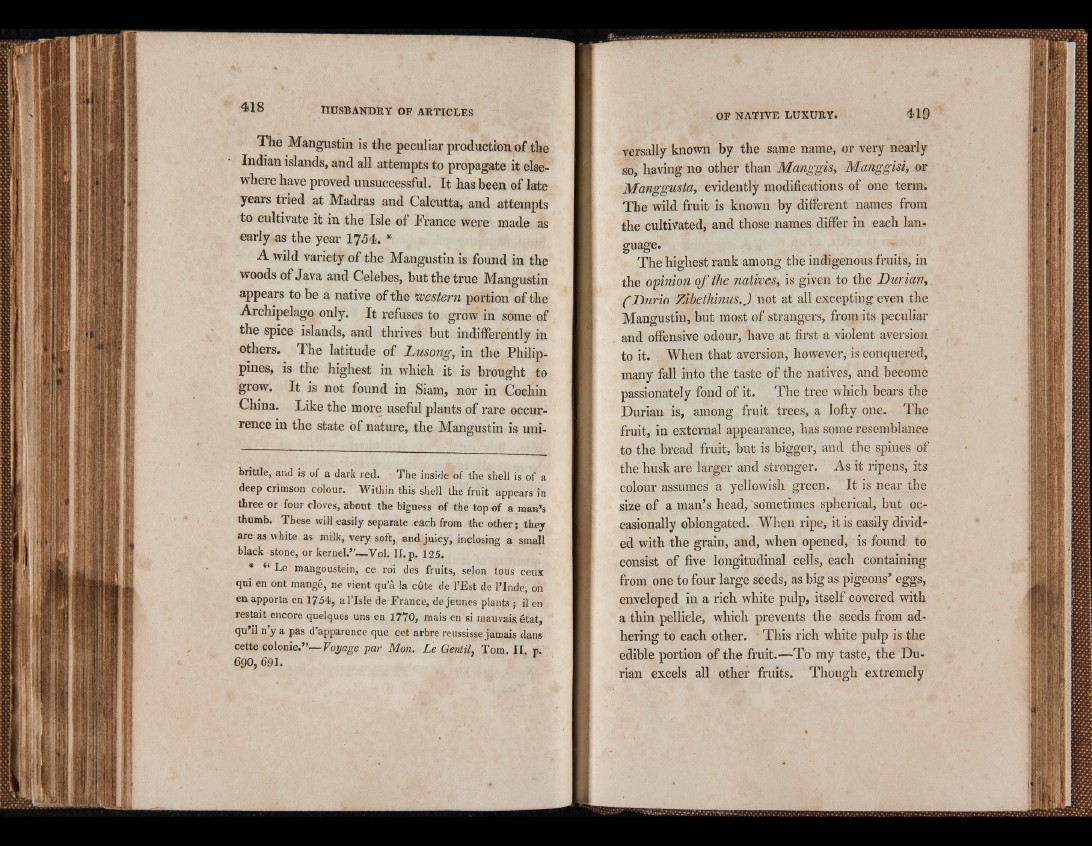
The Mangustin is the peculiar production of the
Indian islands, and all attempts to propagate it elsewhere
have proved unsuccessful. It has been of late
years tried at Madras and Calcutta, and attempts
to cultivate it in the Isle of France were made as
early as the year 1754. *
A wild variety of the Mangustin is found in the
woods of Java and Celebes, but the true Mangustin
appears to be a native of the 'western portion of the
Archipelago only. It refuses to grow in some of
the spice islands, and thrives but indifferently in
others. The latitude of Lusong, in the Philippines,
is the highest in which it is brought to
grow. It is not found in Siam, nor in Cochin
China. Like the more useful plants of rare occurrence
in the state of nature, the Mangustin is unibrittle,
and is of a dark red. The inside of the shell is of a
deep crimson colour. Within this shell the fruit appears in
three or four cloves, about the bigness of the top of a man's
thumb. These will easily separate each from the other; they
are as white as milk, very soft, and juicy, inclosing a small
black stone, or kernel.”—Vol. II. p, 125.
* £< Le mangoustein, ce roi des fruits, selon tous ceux
qui en ont mangé, ne vient qu’à la côte de l’Est de l’Inde, on
en apporta en 1754, a l ’lsle de-France, de jeunes plants ; il en
restait encore quelques uns en 1770, mais en si mauvais état,
qu’il n’y a pas d’apparence que cet arbre réussisse jamais dans
cette colonie.”— Voyage par Mon. Le Gentil, Tom. IL p.
690, 691.
versally known by the same name, or very nearly
so, having no other than Mctnggis, Manggisi, or
Manggusta, evidently modifications of one term.
The wild fruit is known by different names from
the cultivated, and those names differ in each language.
The highest rank among the indigenous fruits, in
the opinion o f the natives, is given to the Durian,
CDurio Zihethinus,) not at all excepting even the
Mangustin, but most of strangers, from its peculiar
and offensive odour, have at first a violent aversion
to it. When that aversion, however, is conquered,
many fall into the taste of the natives, and become
passionately fond of it. The tree which bears the
Durian is, among fruit trees, a lofty one. The
fruit, in external appearance, has some resemblance
to the bread fruit, but is bigger, and the spines of
the husk are larger and stronger. As it ripens, its
colour assumes a yellowish green. It is near the
size of a man’s head, sometimes spherical, but occasionally
oblongated. When ripe, it is easily divided
with the grain, and, when opened, is found to
consist of five longitudinal cells, each containing
from one to four large seeds, as big as pigeons’ eggs,
enveloped in a rich white pulp, itself covered with
a thin pellicle, which prevents the seeds from adhering
to each other. This rich white pulp is the
edible portion of the fruit.—To my taste, the Durian
excels all other fruits. Though extremely